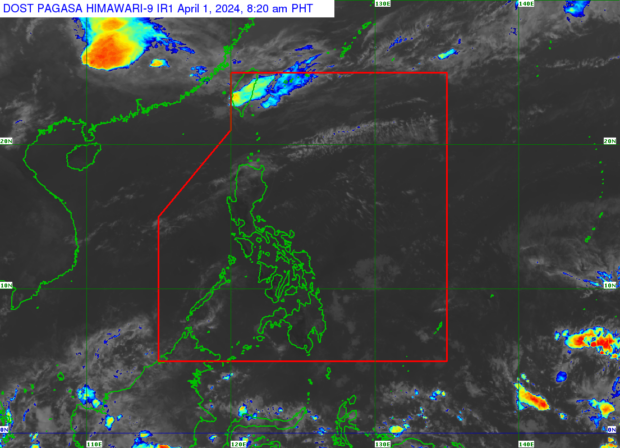Pagasa: High pressure area affects Northern and Central Luzon

Part of a high pressure area is affecting the eastern sections of Northern and Central Luzon on April 1, 2024, according to the Philippine Atmospheric, Geophysical and Astronomical Services Administration (Pagasa). Photo from Pagasa
MANILA, Philippines — The Philippine Atmospheric, Geophysical and Astronomical Services Administration (Pagasa) said there would be “less cloud formation” in the eastern sections of Northern and Central Luzon on Monday due to a ridge of high pressure area (HPA).
Such a condition means a slim chance of rain falling over the affected areas, according to the state meteorologist.
“The difference (of HPA) from a low pressure area (LPA), is that there is less cloud formation. Because if the low pressure area has incoming wind (and) forms clouds, with a ridge of high-pressure area, the air goes outward, so there is not much cloud formation,” Pagasa specialist Obet Badrina explained in Filipino during a public report.
Pagasa also said in an advisory that the easterlies would continue to bring hot and humid weather to many parts of the Philippines on April 1.
READ: Easterlies to bring hot and humid weather on Easter, says Pagasa
Article continues after this advertisementHowever, rains are likely to occur in some areas such as the eastern sections of Southern Luzon, Visayas, and Mindanao.
Article continues after this advertisement“Isolated rain showers and thunderstorms are still possible,” Badrina said.
He likewise mentioned that Pagasa is not monitoring any LPA within the Philippine area of responsibility on the first day of the month and that weather disturbances are unlikely to form this week.
READ: Heat index hits danger level in 5 areas on Easter Sunday
The weather expert further said that no gale warning is hoisted over the country’s seaboards, but advised sailors to regularly check Pagasa’s thunderstorm advisories before sea travel.
Pagasa’s public report also revealed the possible temperature ranges in key cities or areas of the country for April 1:
- Metro Manila: 25 to 34 degrees Celsius
- Baguio City: 16 to 27 degrees Celsius
- Laoag City: 26 to 33 degrees Celsius
- Tuguegarao: 24 to 36 degrees Celsius
- Legazpi City: 25 to 31 degrees Celsius
- Tagaytay: 24 to 32 degrees Celsius
- Puerto Princesa City: 26 to 34 degrees Celsius
- Kalayaan Islands: 26 to 34 degrees Celsius
- Iloilo City: 26 to 32 degrees Celsius
- Metro Cebu: 27 to 31 degrees Celsius
- Tacloban City: 26 to 31 degrees Celsius
- Cagayan De Oro City: 25 to 31 degrees Celsius
- Zamboanga City: 25 to 35 degrees Celsius
- Metro Davao: 24 to 34 degrees Celsius
The forecast temperature range, however, is different from the predicted heat index, which is also known as the apparent temperature.
Pagasa defines heat index as “a human discomfort index that gives the apparent temperature on what humans perceive or feel as the temperature (from the surroundings) affecting the body.”
“High air temperature and high relative humidity results to high apparent temperature,” it adds.